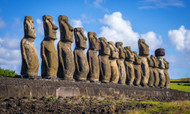Interesting Secrets about Rapa Nui Will Surprise You
Posted by Maris on 11th Jun 2024
Rapa Nui, also known as Easter Island, is a remote island in the southeastern Pacific Ocean, famous for its mysterious and monumental statues called moai. The secrets of Rapa Nui encompass its unique culture, the construction and transportation of the moai, and the island’s ecological and societal changes. Here are some of the intriguing aspects of Rapa Nui:
1. The Moai Statues

- Construction: The moai are monolithic statues carved from volcanic tuff found at the Rano Raraku quarry. These statues, averaging about 13 feet tall and weighing 14 tons, represent the island's ancestors and were believed to hold spiritual significance.
- Transportation: One of the greatest mysteries is how the Rapa Nui people transported these massive statues across the island. Theories suggest they used a combination of log rollers, ropes, and human manpower. Some researchers believe the statues were "walked" upright in a rocking motion using ropes, as demonstrated in modern experiments.
2. Ahu Platforms

- Function: The moai were placed on stone platforms called ahu, which served as ceremonial sites. These platforms are often located along the coastline, facing inland to watch over the communities.
- Engineering: The construction of the ahu demonstrates advanced engineering skills, with some platforms weighing several tons and being precisely fitted together without mortar.

3. Rongorongo Script

- Undeciphered Writing: Rapa Nui is home to a unique script, Rongorongo, inscribed on wooden tablets. This script remains undeciphered despite numerous attempts, and its purpose and meaning are still unknown. It could hold key insights into the island's history and culture.
4. Ecological Collapse

- Deforestation: Rapa Nui once had a lush environment, but extensive deforestation occurred, likely due to the overuse of trees for transporting moai, building canoes, and as fuel. Losing trees led to soil erosion and a decline in agricultural productivity.
- Impact on Society: The ecological collapse contributed to societal changes, including resource scarcity, internal conflicts, and population decline. The islanders adapted by shifting their diet and agricultural practices, but the society eventually experienced significant disruption.
5. Cultural Adaptation and Survival

- Subsistence Farming: The Rapa Nui people developed innovative agricultural techniques to cope with the harsh environment, such as stone mulch gardens called manavai, which helped retain soil moisture and protect crops from the wind.
- Birdman Cult: Following the decline in moai construction, the islanders developed the Birdman cult (Tangata Manu), centered around a competition to collect the first sooty tern egg from the islet of Motu Nui. This cult played a significant role in their religious and political life.
6. European Contact
- Discovery and Impact: European contact began in 1722 with the arrival of Dutch explorer Jacob Roggeveen. Subsequent visits by Europeans brought diseases and slave raids and introduced new animals and plants, leading to further societal disruptions.
- Annexation by Chile: In the late 19th century, Chile annexed Rapa Nui. The island’s population dwindled, and the remaining Rapa Nui people were confined to a small area while the rest of the island was used for sheep farming.
7. Modern Discoveries and Research

- Archaeological Studies: Ongoing archaeological research continues to uncover new information about the island's history, including discovering previously unknown moai and insights into the island’s pre-European societal organization.
- Conservation Efforts: Today, efforts are being made to preserve Rapa Nui's cultural heritage and natural environment. The Rapa Nui National Park, a UNESCO World Heritage site, helps protect the moai and other archaeological sites.
8. Cultural Revival

- Heritage and Identity: The Rapa Nui people are actively working to revive their cultural traditions, language, and practices. To maintain their unique cultural identity, they celebrate festivals, traditional music, dance, and crafts.
- Tourism plays a significant role in the island’s economy, with visitors drawn to the mysterious moai and the island’s rich cultural heritage. However, this also brings challenges and opportunities for sustainable development and cultural preservation.
Rapa Nui remains a place of great mystery and fascination, with its history, culture, and monumental achievements continuing to captivate researchers and visitors alike.

